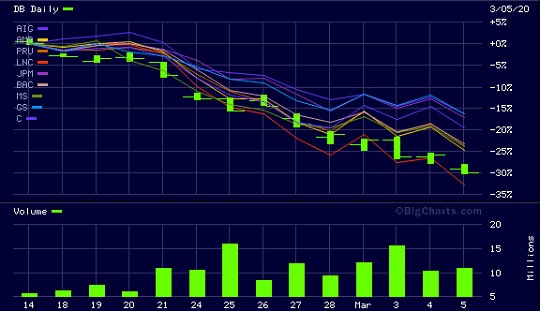Courtesy of Pam Martens
Deutsche Bank Trading Chart from February 14 through March 5 Versus AIG, Ameriprise Financial (AMP), Prudential Financial (PRU), Lincoln National (LNC), JPMorgan Chase (JPM), Bank of America (BAC), Morgan Stanley (MS), Goldman Sachs (GS) and Citigroup (C).
By Pam Martens and Russ Martens
Yesterday, the Dow Jones Industrial Average of 30 large cap companies closed with a loss of 969.5 points or 3.58 percent. That was bad enough but the losses among the biggest Wall Street banks outpaced the Dow losses by a significant margin. Typically, JPMorgan Chase is one of the better performers among the Wall Street banks in the midst of a big selloff. But not yesterday. It closed with a loss of 4.91 percent – a loss larger than Goldman Sachs (-4.77 percent), which has a large criminal fine hanging over its head. The news that Jamie Dimon, Chairman and CEO of JPMorgan Chase, had heart surgery on Thursday was not reported until after the stock market had closed.
The losses among the other mega banks on Wall Street yesterday were equally unsettling. Morgan Stanley lost 5.86 percent; Citigroup closed down 5.79 percent, while Bank of America shed 5.07 percent.
All of these banks have one thing in common: they each are exposed to tens of trillions of dollars in derivatives. And according to a 2016 report from the International Monetary Fund (IMF), the German mega bank, Deutsche Bank, is heavily interconnected via derivatives to each of these Wall Street banks. (See chart below.) Deutsche Bank’s stock lost 5.49 percent yesterday, bringing its losses to 30 percent in just the past 15 trading sessions. That’s common equity capital that Deutsche Bank can’t afford to lose: its shares have lost 75 percent of their common equity value in the past five years. The IMF concluded that Deutsche Bank posed a greater threat to global financial stability than any other bank as a result of these interconnections – and that was when its market capitalization was tens of billions of dollars larger than it is today.
On July 21, 2011, when the Government Accountability Office (GAO) released its audit of the Federal Reserve’s secret $16.1 trillion in bank bailout loans during the financial crisis, the bank that ranked number 9 on the list for the largest amount of loans wasn’t even a U.S. bank – it was Deutsche Bank. The Fed had funneled a cumulative $354 billion in revolving loans to Deutsche Bank. Two other foreign banks had received even more in Fed loans than Deutsche Bank: the U.K. bank, Barclays, had received $868 billion while the Royal Bank of Scotland Group PLC, also of the U.K., had received $541 billion from the Fed.
…




